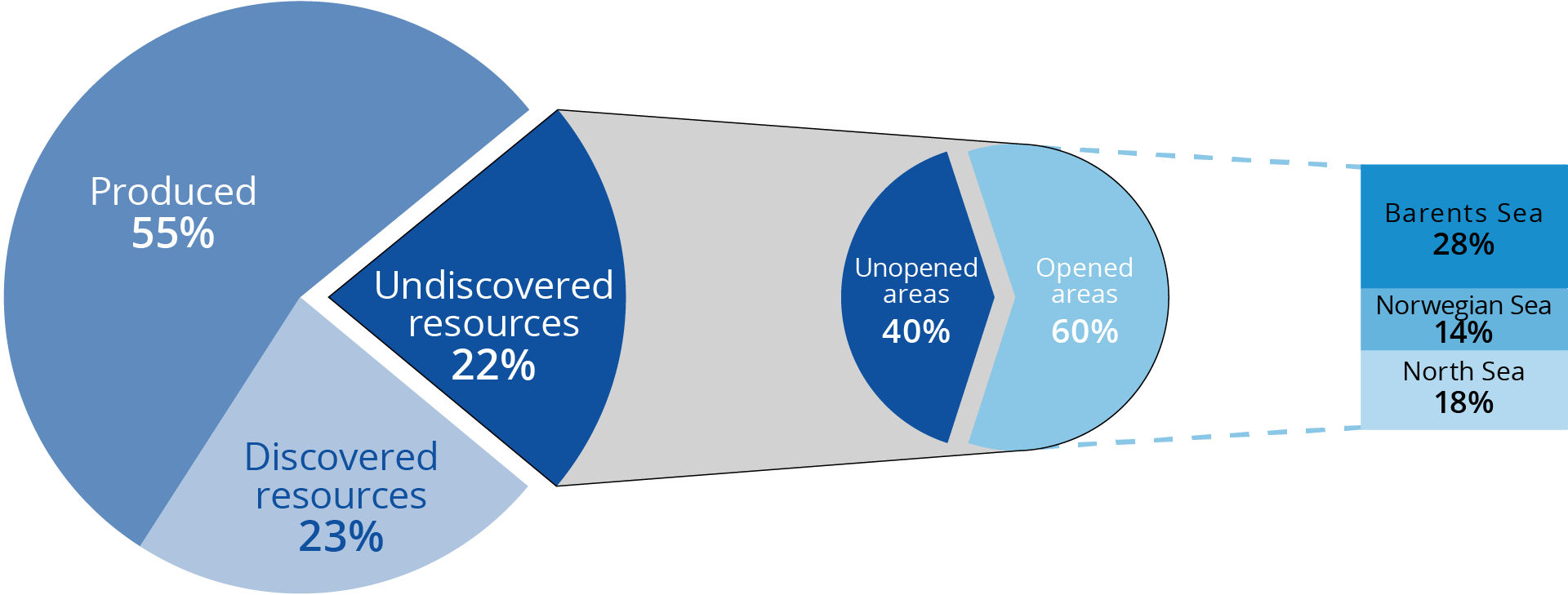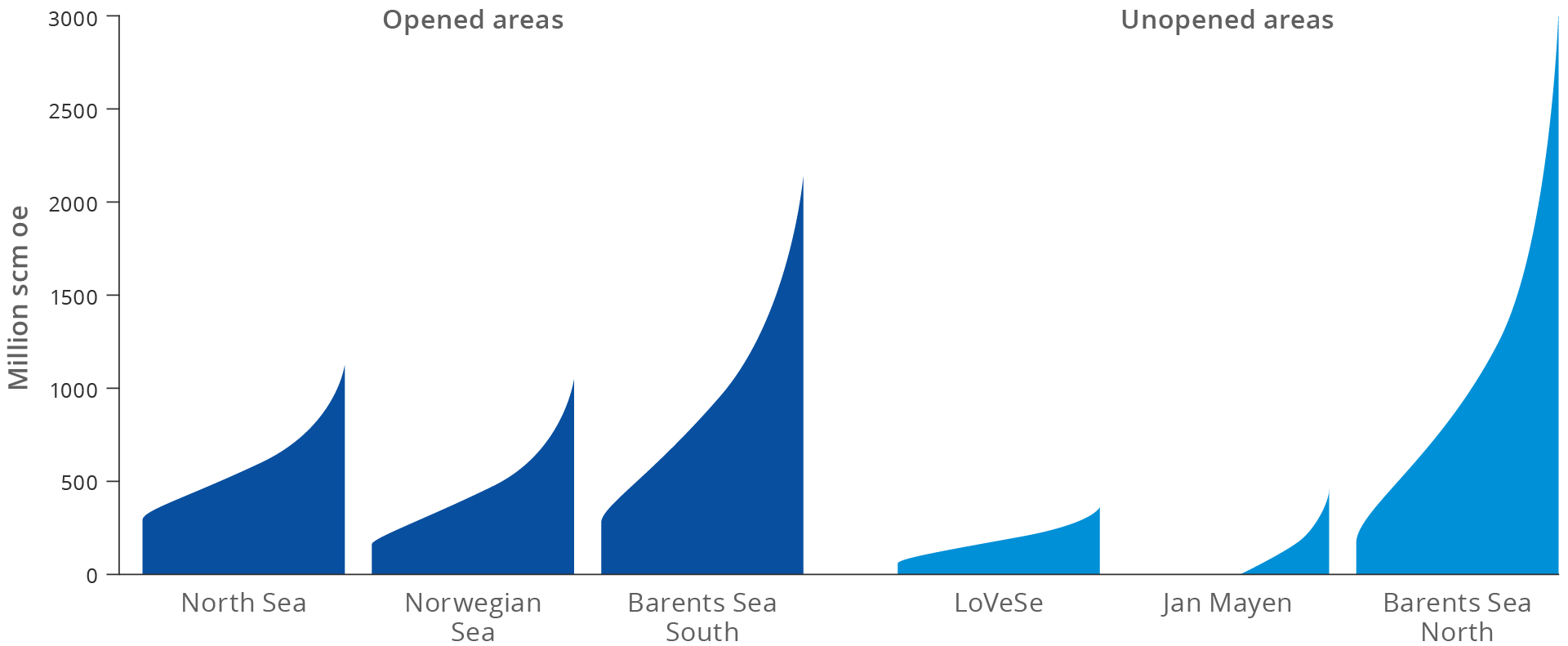3 – Undiscovered resources
Shortcut:
- 3.1 Undiscovered resources in opened and unopened areas
- 3.2 Undiscovered resources in Norwegian ocean areas
Undiscovered resources are volumes of petroleum that we project could be recovered from deposits not yet proven through drilling. The estimates for undiscovered resources in areas opened for petroleum activities are updated on an annual basis. The update is based on assessments surrounding the previous year's exploration results, any potential new studies, as well as relevant information from the companies.
In areas that have not been opened for petroleum activities, the estimates are only updated if new data has been acquired in the area which has provided significant new information.

Figure 3-1 Distribution of undiscovered liquids and gas in the various ocean areas with range of uncertainty.
The pie chart in Figure 3-1 shows the percentage distribution between overall undiscovered resources in each ocean area. About 60 per cent of the undiscovered resources are in the Barents Sea. The Barents Sea North is the ocean area with the highest estimate for undiscovered liquids resources, while the Barents Sea South has the equivalent for gas resources. These are the ocean areas with the greatest uncertainty, which is reflected in the considerable range between the high and low estimates.
There are considerable undiscovered resources in the North Sea and Norwegian Sea as well. Due to existing infrastructure, there is a considerable potential for value creation in these ocean areas, even in discoveries of minor deposits. In the North Sea, we expect liquids to account for the largest share, while there is an equal distribution between undiscovered liquids and gas in the Norwegian Sea.
The range of uncertainty shown in Figure 3-1 is from P95 to P05, which means that it is 95 per cent likely that the volume of undiscovered resources is higher than this value, and 5 per cent likely that the volume is greater than this value. The figures are listed in Tabell 31.

Table 3-1 Undiscovered resources by ocean area with range of uncertainty.
3.1. Undiscovered resources in opened and unopened areas
The Norwegian Offshore Directorate expects undiscovered resources to make up 22 per cent of the overall resources on the Norwegian shelf. 60 per cent of this is in opened areas. These are distributed across 28 per cent in the Barents Sea, 14 per cent in the Norwegian Sea and 18 per cent in the North Sea, as shown in Figure 3-2.

Figure 3-2 Distribution of undiscovered resources across opened and unopened areas.

Figure 3-3 Undiscovered resources in opened and unopened areas with range of uncertainty. LoVeSe is an abbreviation for the areas of Lofoten, Vesterålen and Senja.
Despite the somewhat greater resource potential in the opened areas, the upside is greatest in the unopened part of the Barents Sea (Barents Sea North). This is also the area with the greatest uncertainty, as shown in Figure 3-3. The resources in LoVeSe are distributed between the Norwegian Sea and the Barents Sea South.

Table 3-2 Undiscovered resources by ocean area, in opened and unopened areas.
3.2. Undiscovered resources in Norwegian ocean areas
North Sea
The estimate for undiscovered resources in the North Sea is 610 million Sm3 of recoverable o.e. This is distributed between 395 million Sm3 of oil and condensate (liquids) and 215 billion Sm3 of gas, which represents a reduction of 25 million Sm3 of recoverable o.e from the previous year. The decline reflects that there was significant exploration activity in the North Sea in 2023, with a total of 17 completed wildcat wells.
Even in a mature area such as the North Sea, there is still significant uncertainty in the estimates for undiscovered resources, as illustrated in Figure 3.1. The figure shows a probability distribution where the low end is the P95 estimate, and the high end is the P05-estimate. These figures indicate the expected value in the distribution. This is normally somewhat higher than the P50 value.
Even if one cannot rule out that larger discoveries could be made in the North Sea, we expect that the majority of discoveries will be relatively small. The average discovery size in the North Sea over the last five years is about 3.5 million Sm3 of recoverable o.e.
Norwegian Sea
The estimate for undiscovered resources in the Norwegian Sea is 725 million Sm3 of recoverable o.e. This is distributed between 350 million Sm3 of liquids and 375 billion Sm3 of gas.
The resource estimates for the Norwegian Sea also include the resource volumes in the unopened areas off Lofoten and Vesterålen, as well as in the ocean area around Jan Mayen. These constitute about 33 per cent of the overall estimate. See Table 3-2 for the distribution between opened and unopened areas.
The average discovery size in the Norwegian Sea has increased over the last five years and is now 4.5 million Sm3 of recoverable o.e.
Barents Sea
The estimate for undiscovered resources in the Barents Sea is 2,145 million Sm3 of recoverable o.e. This is distributed between 1,100 million Sm3 of liquids and 1,045 billion Sm3 of gas, which represents a reduction of 250 million Sm3 of recoverable o.e. and is entirety linked to the Barents Sea North.
Barents Sea South
The estimate for undiscovered resources in the Barents Sea South is 1,020 million Sm3 of recoverable o.e. This is distributed between 445 million Sm3 of liquids and 575 billion Sm3 of gas. The changes in resource estimates here are so minor that they have had no impact on the rounded resource figures stated above.
The Barents Sea South has seen a relatively low level of exploration activity over the last five years. Only 18 wildcat wells have been completed, which is a reduction of nearly 50 per cent compared with the previous five-year period. A total of eight discoveries were made in these 18 wells, and the last six wells have all yielded discoveries. The average discovery size is about 4.3 million Sm3 of recoverable o.e.
Barents Sea North
In the Barents Sea, about 54 per cent of the resources are located in areas that have not been opened for petroleum activities, primarily in the Barents Sea North. This is the area with the highest likelihood of making new, major discoveries on the Norwegian shelf, but it is also the area with the greatest uncertainty. The Norwegian Offshore Directorate has conducted a geological evaluation of parts of the Barents Sea North based on new data acquired since the previous mapping in 2016. This has led to an update of the resource estimate for the area.
The estimate for undiscovered resources in the Barents Sea North is 1,125 million Sm3 of recoverable o.e. This is distributed between 655 million Sm3 of liquids and 470 billion Sm3 of gas.
The overall resources have been reduced by 18 per cent from the previous estimate, which was 1,375 million Sm3 of recoverable o.e. In percentage terms, this reduction is greater for liquids (21 per cent) than for gas (14 per cent).